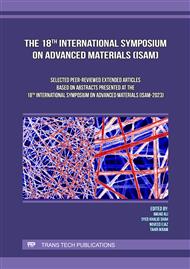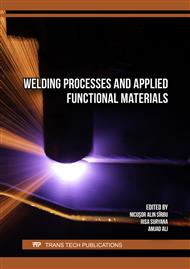[1]
S.M. Kurtz, The UHMWPE handbook: ultra-high molecular weight polyethylene in total joint replacement. Elsevier, 2004.
Google Scholar
[2]
S.J. Gobbi, V.J. Gobbi, and Y. Rocha, "Requirements for selection/development of a biomaterial," Biomedical Journal of Scientific & Technical Research, vol.14,no.3, pp.1-6, 2019.
DOI: 10.26717/bjstr.2019.14.002554
Google Scholar
[3]
A.W. Batchelor and M. Chandrasekaran, Service characteristics of biomedical materials and implants. Imperial College Press, 2004.
Google Scholar
[4]
P.F. Gomez and J.A. Morcuende, "A historical and economic perspective on Sir John Charnley, Chas F. Thackray Limited, and the early arthroplasty industry," The Iowa orthopaedic journal, vol. 25, p.30, 2005.
Google Scholar
[5]
E.M. Brach del Prever, A. Bistolfi, P. Bracco, and L. Costa, "UHMWPE for arthroplasty: past or future?," Journal of Orthopaedics and Traumatology, vol. 10, no. 1, pp.1-8, 2009.
DOI: 10.1007/s10195-008-0038-y
Google Scholar
[6]
C.O.N.C. Research. "KNEE REPLACEMENT SURGERY BY THE NUMBERS. "https://www.thecenteroregon.com/medical-blog/knee-replacement-surgery-by-the numbers (accessed 2022).
Google Scholar
[7]
N. Shahemi, S. Liza, A. Abbas, and A. M. Merican, "Long-term wear failure analysis of uhmwpe acetabular cup in total hip replacement," Journal of the mechanical behavior of biomedical materials, vol. 87, pp.1-9, 2018.
DOI: 10.1016/j.jmbbm.2018.07.017
Google Scholar
[8]
M. Key. "Damage of Implant Surfaces in Total Knee Arthroplasty." https://musculoskeletalkey.com/damage-of-implant-surfaces-in-total-knee-arthroplasty/ (accessed 2022.
DOI: 10.1302/3114-220806
Google Scholar
[9]
S.M. Kurtz, O.K. Muratoglu, M. Evans, and A.A. Edidin, "Advances in the processing, sterilization, and crosslinking of ultra-high molecular weight polyethylene for total joint arthroplasty," Biomaterials, vol. 20, no. 18, pp.1659-1688, 1999.
DOI: 10.1016/s0142-9612(99)00053-8
Google Scholar
[10]
R. Barbucci, Integrated biomaterials science. Springer Science & Business Media, 2002.
Google Scholar
[11]
M.B. Turell and A. Bellare, "A study of the nanostructure and tensile properties of ultra-high molecular weight polyethylene," Biomaterials, vol. 25, no. 17, pp.3389-3398, 2004.
DOI: 10.1016/j.biomaterials.2003.10.027
Google Scholar
[12]
S. Ray, Applications of graphene and graphene-oxide based nanomaterials. William Andrew, 2015.
Google Scholar
[13]
D. Sharma, S. Kanchi, M.I. Sabela, and K. Bisetty, "Insight into the biosensing of graphene oxide: Present and future prospects," Arabian Journal of Chemistry, vol. 9, no. 2, pp.238-261, 2016.
DOI: 10.1016/j.arabjc.2015.07.015
Google Scholar
[14]
C. Chung, Y.-K. Kim, D. Shin, S.-R. Ryoo, B.H. Hong, and D.-H. Min, "Biomedical applications of graphene and graphene oxide," Accounts of chemical research, vol. 46, no. 10, pp.2211-2224, 2013.
DOI: 10.1021/ar300159f
Google Scholar
[15]
Y. Wang, Z. Li, D. Hu, C.-T. Lin, J. Li, and Y. Lin, "Aptamer/graphene oxide nanocomplex for in situ molecular probing in living cells," Journal of the American Chemical Society, vol. 132, no. 27, pp.9274-9276, 2010.
DOI: 10.1021/ja103169v
Google Scholar
[16]
L. Shahriary and A.A. Athawale, "Graphene oxide synthesized by using modified hummers approach," Int. J. Renew. Energy Environ. Eng, vol. 2, no. 01, pp.58-63, 2014.
Google Scholar
[17]
W.S. Hummers Jr and R.E. Offeman, "Preparation of graphitic oxide," Journal of the american chemical society, vol. 80, no. 6, pp.1339-1339, 1958.
DOI: 10.1021/ja01539a017
Google Scholar
[18]
D.C. Marcano et al., "Improved synthesis of graphene oxide," ACS nano, vol. 4, no. 8, pp.4806-4814, 2010.
Google Scholar
[19]
F. Pendolino, N. Armata, T. Masullo, and A. Cuttitta, "Temperature influence on the synthesis of pristine graphene oxide and graphite oxide," Materials Chemistry and Physics, vol. 164, pp.71-77, 2015.
DOI: 10.1016/j.matchemphys.2015.08.024
Google Scholar
[20]
S. Tkachev, E. Y. Buslaeva, A. Naumkin, S. Kotova, I. Laure, and S. Gubin, "Reduced graphene oxide," Inorganic Materials, vol. 48, no. 8, pp.796-802, 2012.
DOI: 10.1134/s0020168512080158
Google Scholar
[21]
S.H. Huh, "Thermal reduction of graphene oxide," Physics and applications of graphene-experiments, vol. 19, pp.73-90, 2011.
Google Scholar
[22]
E.T. Thostenson, C. Li, and T.-W. Chou, "Nanocomposites in context," Composites science and technology, vol. 65, no. 3-4, pp.491-516, 2005.
DOI: 10.1016/j.compscitech.2004.11.003
Google Scholar
[23]
T.A. Osswald, L.-S. Turng, and P.J. Gramann, Injection molding handbook. Hanser Verlag, 2008.
Google Scholar
[24]
R.M. Gul, "Improved UHMWPE for use in total joint replacement," Massachusetts Institute of Technology, 1997.
Google Scholar
[25]
AZO Materials.https://www.azom.com/article.aspx?ArticleID=9153. (accessed 2022).
Google Scholar
[26]
R.M. Gul and F.J. McGarry, "Processing of ultra‐high molecular weight polyethylene by hot isostatic pressing, and the effect of processing parameters on its microstructure," Polymer Engineering & Science, vol. 44, no. 10, pp.1848-1857, 2004.
DOI: 10.1002/pen.20186
Google Scholar
[27]
N. Parasnis and K. Ramani, "Analysis of the effect of pressure on compression moulding of UHMWPE," Journal of Materials Science: Materials in Medicine, vol. 9, no. 3, pp.165-172, 1998.
Google Scholar



